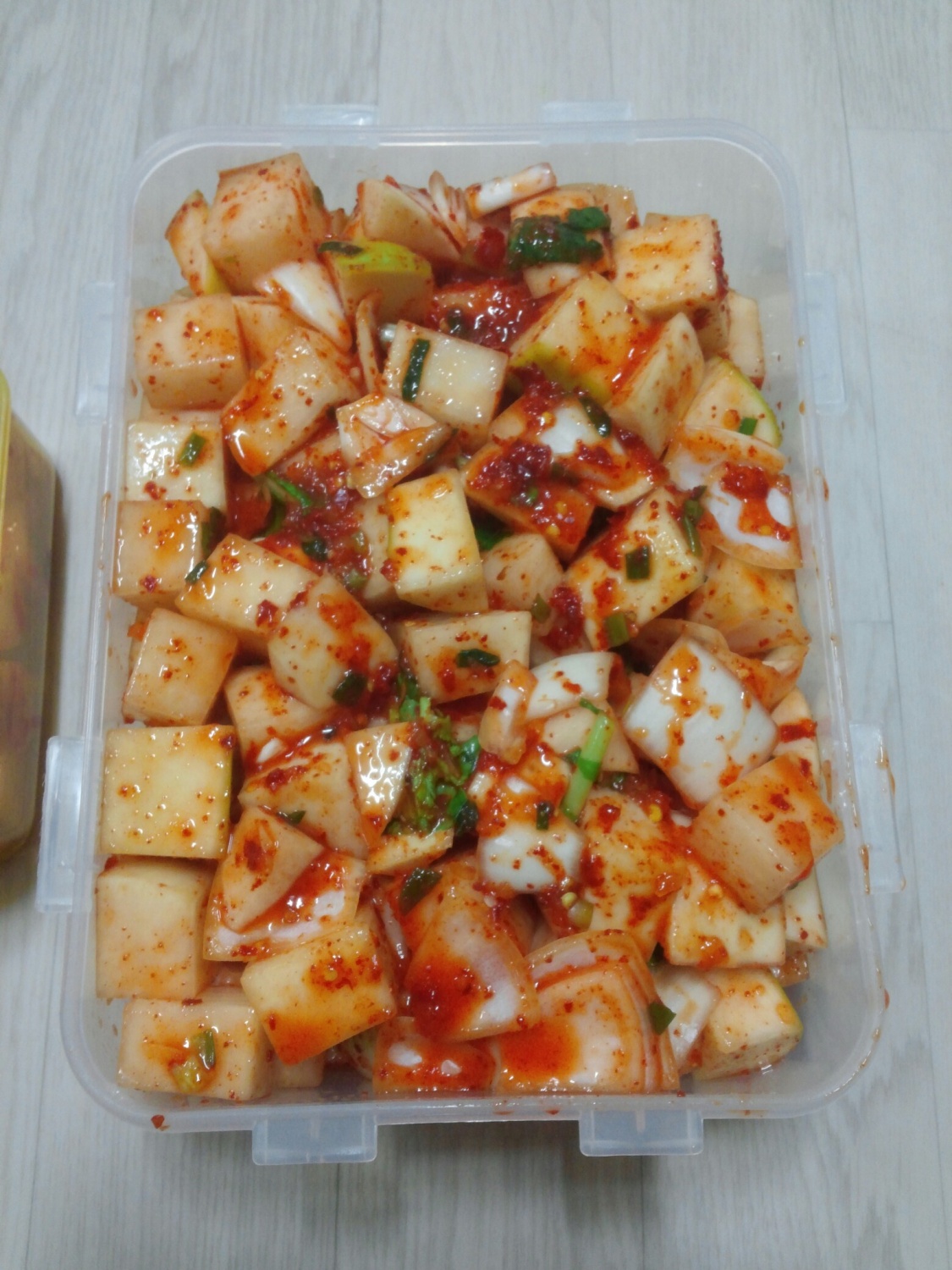Perfectly Aged Delicious Kkakdugi (Cubed Radish Kimchi)
Easy Kkakdugi with Flour Paste for Kimchi – Foolproof Recipe

Create a delightful side dish using leftover ingredients from your kitchen! This recipe is designed to be foolproof, ensuring a tasty Kkakdugi even if you’re a beginner. We’ll use a special flour paste made with anchovy-kelp broth for enhanced umami, and you can easily adjust it to your personal taste. Making delicious Kkakdugi is simpler than you think!
Main Ingredients- 1.8~2kg Korean radish (mu)
- 1/2 onion
- 3-5 stalks of chives (or green onions)
- 1 bunch of radish greens (or young radish leaves)
Seasoning Ingredients- 180-200cc Kimchi flour paste (made with 200cc broth, 15cc flour, 2.5cc sugar, 1.3cc MSG)
- 5 dried red chilies (or fresh red chilies)
- 75cc anchovy sauce (or 15cc salt)
- 60cc fish sauce (e.g., Kkanari) (or 15cc salt)
- 45-60cc red pepper flakes (gochugaru)
- 15cc minced garlic
- 15cc plum extract (or 30cc sugar)
- 0.3cc ginger powder (optional, may add a slight bitterness)
- 15-30cc additional anchovy sauce for seasoning adjustment
- 180-200cc Kimchi flour paste (made with 200cc broth, 15cc flour, 2.5cc sugar, 1.3cc MSG)
- 5 dried red chilies (or fresh red chilies)
- 75cc anchovy sauce (or 15cc salt)
- 60cc fish sauce (e.g., Kkanari) (or 15cc salt)
- 45-60cc red pepper flakes (gochugaru)
- 15cc minced garlic
- 15cc plum extract (or 30cc sugar)
- 0.3cc ginger powder (optional, may add a slight bitterness)
- 15-30cc additional anchovy sauce for seasoning adjustment
Cooking Instructions
Step 1
First, prepare the flour paste for kimchi. Dissolve 15cc of flour in 200cc of water, bring to a boil, and cook until thickened. For added flavor, you can mix in 2.5cc of sugar and 1.3cc of MSG. (Refer to my other recipe @6877888 for detailed flour paste instructions.)

Step 2
Soak 5 dried red chilies in water for about 30 minutes until softened. You can also use fresh red chilies. Removing the seeds from the soaked chilies will make the Kkakdugi less spicy.

Step 3
Select one Korean radish (mu) weighing 1.8-2kg that looks fresh and firm. Don’t worry if it’s not perfectly shaped; the taste will be great! Also, prepare 5 stalks of chives (or green onions), 1 bunch of radish greens (or young radish leaves), and 1/2 onion, all thoroughly washed.

Step 4
Cut the 1/2 onion into large, bite-sized cubes, similar to the size of your Kkakdugi pieces. Alternatively, you can finely chop or grate the onion to blend into the seasoning paste for extra flavor.

Step 5
We will not be salting the radish beforehand. Cut the radish into uniform Kkakdugi-sized cubes (approximately 2-3 cm). Leaving it unsalted will allow more moisture to be released as it ferments, resulting in a juicier kimchi.

Step 6
Finely chop the 5 chives. Cut the radish greens (or young radish leaves) into lengths similar to the Kkakdugi pieces. Discard any tough stems and use the leafy parts.

Step 7
Puree the soaked dried red chilies (seeds removed if desired) in a blender with 15cc of minced garlic, 15cc of plum extract (or 30cc of sugar), and 0.3cc of ginger powder (optional; omitting it might result in a slightly bitter note). Aim for a smooth paste.

Step 8
In the blended chili paste, add 75cc of anchovy sauce (or 15cc of salt) and 60cc of fish sauce (e.g., Kkanari) (or 15cc of salt). Mix well to create the seasoning base. This amount of salt is suitable for approximately 1.8-2kg of unsalted radish, equivalent to about 45cc of salt.

Step 9
To the cubed radish that hasn’t been salted, first add 200cc of the prepared flour paste and mix thoroughly. This step helps the flour paste coat the radish pieces, allowing the seasoning and sauces to adhere better and penetrate the radish.

Step 10
Pour in the prepared seasoning mixture and gently toss to coat all the radish pieces evenly. Taste the mixture and adjust the seasoning if needed by adding 15-30cc more anchovy sauce. Since the Kkakdugi will release a lot of moisture as it ferments, it’s okay if the initial taste is slightly saltier; the liquid will dilute the flavor as it matures.

Step 11
Add 45cc of red pepper flakes (gochugaru) for vibrant color and mix well. You can add an extra 15cc if you prefer a deeper red hue.

Step 12
Finally, add the chopped chives and radish greens (or young radish leaves). Gently mix them in, being careful not to crush the vegetables.

Step 13
Transfer the Kkakdugi into a clean container. Rinse the mixing bowl with a little water and pour any remaining seasoning into the container. Seal the lid tightly. Let it ferment at room temperature for 2-3 days or more, then store it in the refrigerator. The Kkakdugi is ready when the liquid rises to the top of the container, ensuring the flavors are well-distributed and the kimchi is perfectly seasoned.




